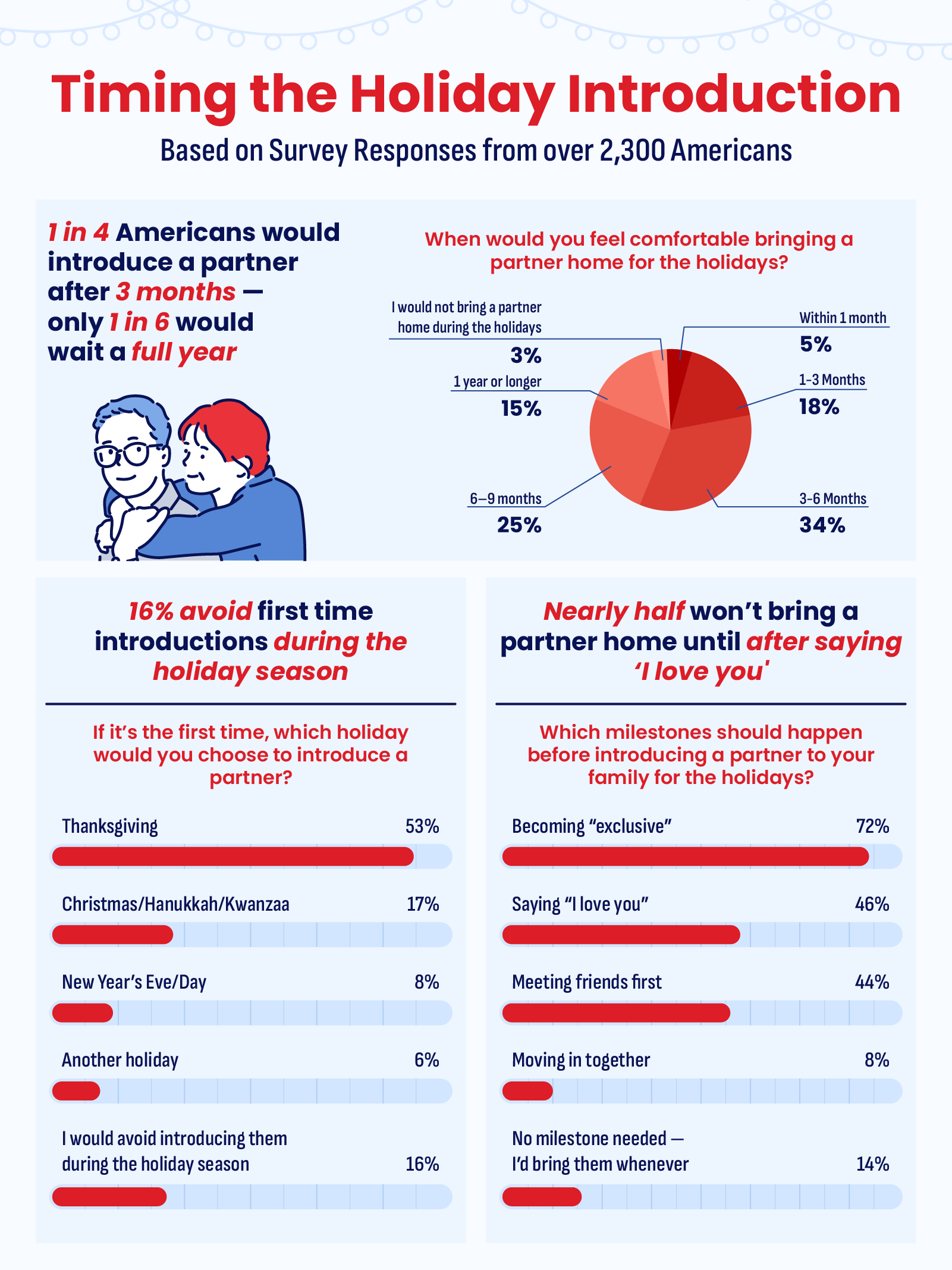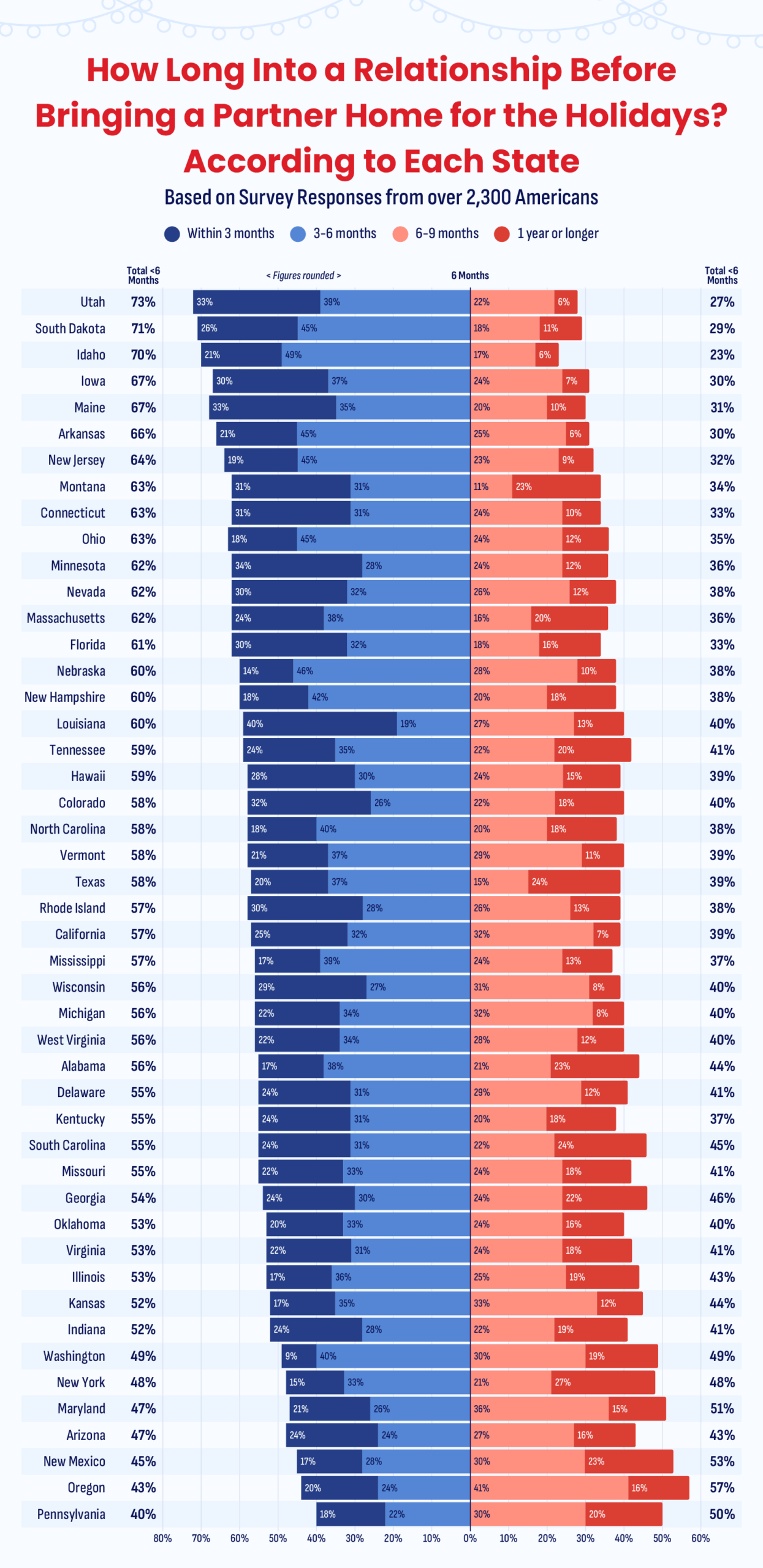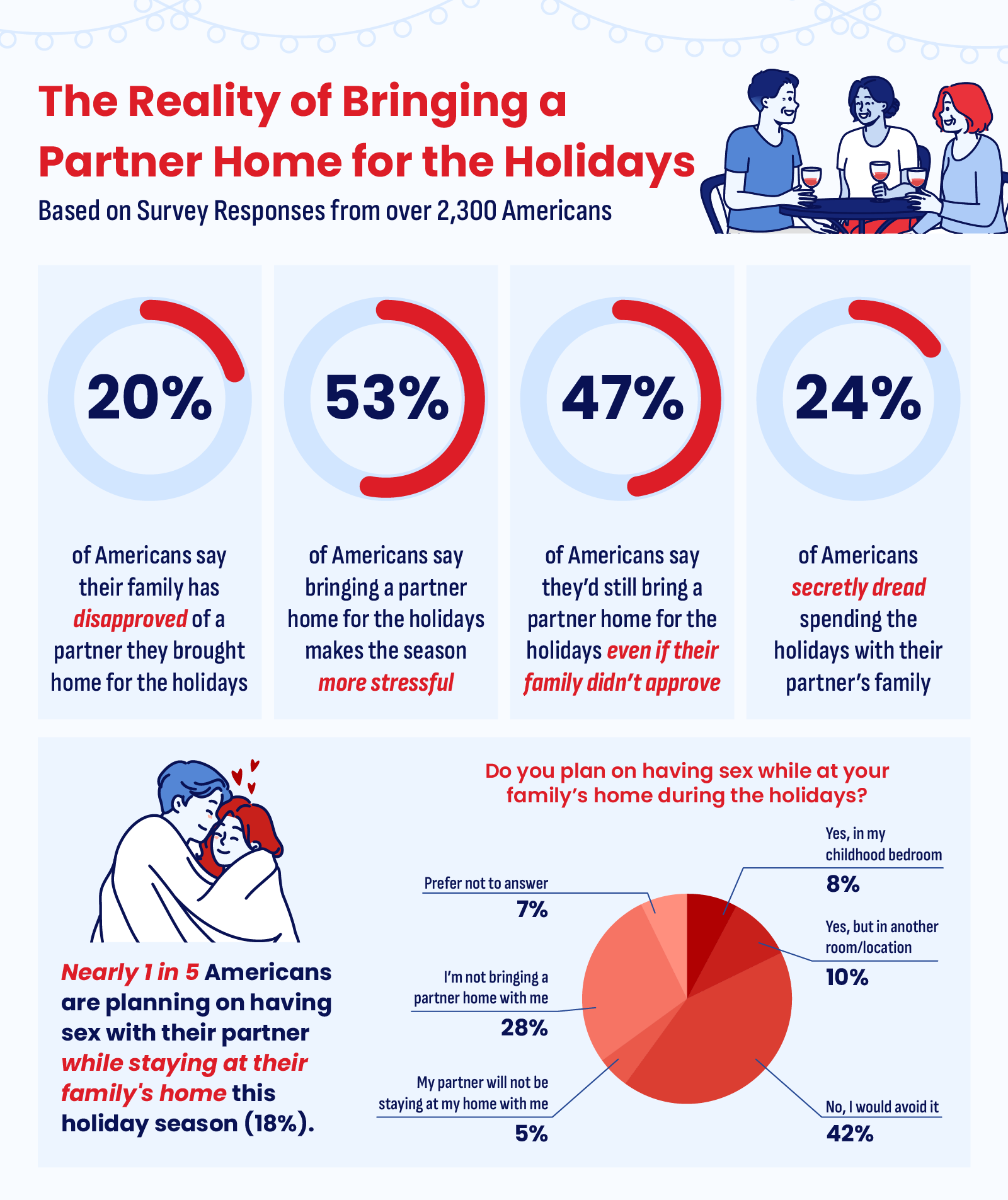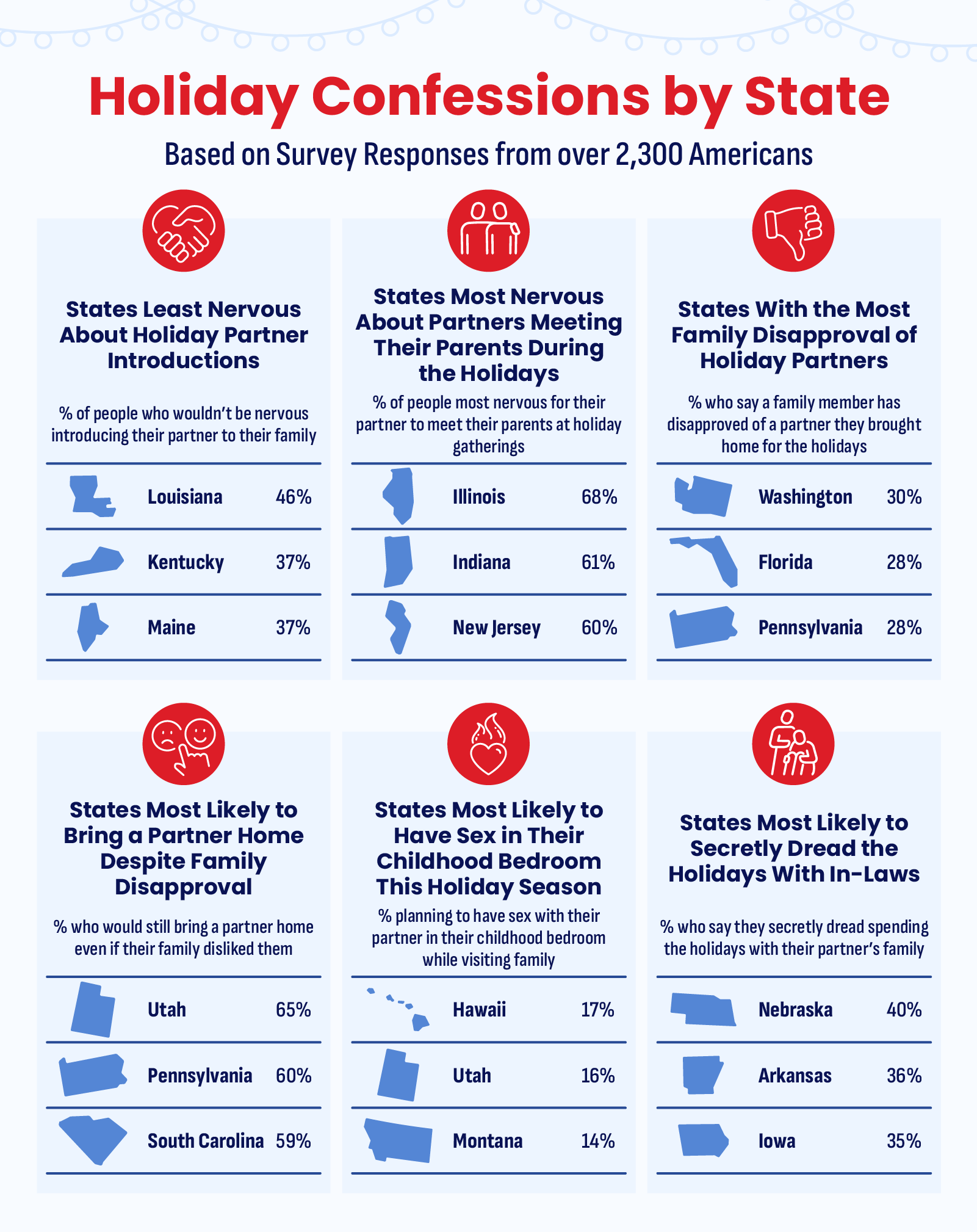When Do Americans Bring a Partner Home for the Holidays?
Most days, relationships feel low-stakes and familiar. The holidays raise the stakes, shifting things from private to public and prompting the question: when do couples say the timing is right, and which celebration most often hosts that first family hello?
We surveyed more than 2,300 Americans across the U.S. to find out when they think it’s appropriate to bring a partner home for the holidays, which holiday is the best for it, and what really happens once everyone’s under the same roof.
Read on to discover a state-by-state look at who’s bringing someone home this year and where residents tend to take their time before ringing the doorbell together.
Key Findings
- One in six (15%) Americans would wait a full year of dating or more before bringing a partner home for the holidays for the first time — yet nearly one in four (23%) would feel ready within the first three months of dating.
- Thanksgiving is the clear favorite for a first family intro (53%), far ahead of Christmas (17%) and New Year’s (11%).
- 53% say bringing a partner home makes the holidays more stressful, while only 23% say it makes the season easier.
- Two in five (40%) Americans have introduced a partner to their family for the first time during the holidays.
When Do Couples Feel Ready to Bring a Partner Home for the Holidays?

When it comes to the timing of bringing your partner home for the holidays, nearly one in four (23%) survey respondents say they would bring a partner home within the first three months of dating, while 15% prefer to wait a year or longer. Most land somewhere in the middle — 34% say three to six months feels right, and another 25% wait six to nine. Another 16% say they’d avoid a first introduction altogether during the holidays.
Women are slightly more likely to take their time — 42% say they would wait six months or longer before bringing home a partner, compared to 35% of men.
In terms of the generation that tends to wait the longest before introducing their partner during the holidays, nearly half of Gen Zers (49%) would hold off at least six months, ahead of Millennials (39%), Gen X (38%), and Baby Boomers (34%).
There are also certain milestones Americans think should come before bringing a partner home for the holidays for the first time. Nearly half of couples say they won’t bring a partner home until after saying “I love you,” and 44% think meeting friends should come before meeting family during the holidays — a sentiment strongest among Gen Z (59%). A smaller group (8%) believes living together should come before any family holiday introductions.
When the time finally feels right, Thanksgiving tops the list as the most popular holiday for a first meeting (53%), followed by Christmas (17%) and New Year’s (11%).
Survey respondents point to parents as the most nerve-wracking audience for introducing their partner (48%). In comparison, only 3% say grandparents make them most nervous — and one in four (25%) say they wouldn’t feel nervous at all for their partner to meet their family members.
How Soon Is Too Soon? By State

These rankings show which states had the highest share of respondents selecting each timeline — meaning these states stood out the most compared to others for that specific response.
Fastest states (highest percentage saying they’d bring a partner home within three months):
- Louisiana — 40.4%
- Minnesota — 34.0%
- Utah — 33.3%
- Maine — 32.7%
- Colorado — 32.0%
In faster-moving states like Colorado, Louisiana, Maine, Minnesota, and Utah, the three-month mark is a common green light for bringing a partner home for the holidays.
Slowest states (highest percentage saying they’d wait a year or more):
- New York — 26.9%
- Texas — 23.7%
- South Carolina — 23.5%
- New Mexico — 23.4%
- Alabama — 23.1%
On the slow-and-steady side, residents in Alabama, New Mexico, New York, South Carolina, and Texas are most likely to wait a year or longer before making that first family introduction.
Who’s Bringing Someone Home This Year?
This year, 42% of Americans say they plan to bring a partner home for the holidays. Here are the top and bottom states that make up this percentage:
The top five states planning to bring a partner home
- Iowa — 60.9% are bringing someone home
- Utah — 60.8%
- Missouri — 56.9%
- South Dakota — 55.3%
- Oklahoma — 53.3%
Some states are especially ready to spend the holidays as a pair. In Iowa, Utah, Missouri, South Dakota, and Oklahoma, more than half of residents plan to bring their partner home this year.
The top five states not planning to bring a partner home
- Texas — 76.3% are not planning to bring a partner home (40.7% are single, 35.6% have a partner but aren’t bringing them home).
- Virginia — 72.6% aren’t bringing a partner home (39.2% single, 33.3% partnered).
- Louisiana — 71.2% aren’t bringing a partner home (30.8% single, 40.4% partnered).
- Mississippi — 69.6% aren’t bringing a partner home (26.1% single, 43.5% partnered).
- Kansas — 67.3% aren’t bringing a partner home (26.9% single, 40.4% partnered).
Residents of Texas, Virginia, Louisiana, Mississippi, and Kansas are the least likely to bring a partner home this holiday season.
The top five states spending the holidays apart
Not everyone skipping the trip home is single. In some states, couples are together but choosing to spend the holidays separately this year.
- Washington — 47.2% have a partner but aren’t bringing them home
- Mississippi — 43.5%
- New Jersey — 41.5%
- Louisiana — 40.4%
- Kansas — 40.4%
Whether it’s due to distance, new relationships, or simply wanting a lower-pressure holiday season, couples in these states are taking time to celebrate apart — at least for this year.
The Joys (and Stresses) of the Holiday Introduction

According to our survey, one in five Americans (20%) say their family has disapproved of a partner they brought home before. That may be why 22% believe a new partner coming for the holidays should show up with gifts for their immediate family.
57% of respondents think a new partner should share the same room when staying over for the holidays. Men are more likely than women to agree with this sentiment (65% vs. 51%), while over a quarter of women (27%) say their partner shouldn’t sleep at their house at all. Age matters too: Gen Z is the most comfortable with room-sharing (69%), compared to just 33% of Baby Boomers.
More than one in three (37%) say introducing a partner feels harder during this time of year, and more than half (53%) of Americans feel bringing a partner home makes the season more stressful, with women (56%) more likely than men (48%) to feel the added pressure. Even among younger adults, 18% of Gen Z say family introductions make the holiday season much more stressful.
Nearly half (47%) say they would still bring a partner home even if their family didn’t approve. That said, women are more likely than men to hold off on bringing their partner home for the holidays without family approval (56% vs. 49%).
Regarding romance, nearly one in five (18%) Americans plan to have sex while staying at their family’s home this season, and 8% say it will happen in their childhood bedroom. Men are more likely than women to plan on intimacy (25% vs. 14%) and more than twice as likely to admit they’d do so in their childhood room (13% vs. 5%). A discreet 7% say they’ve been caught being intimate while visiting family during the holidays — men (10%) report this nearly twice as often as women (6%).
Behind the Scenes of Holiday Introductions — by State

Using responses from our nationwide survey, we identified how sentiments around bringing a partner home for the holidays vary across the country.
The states least likely to feel nervous about holiday introductions
Louisiana (46%), Kentucky (37%), and Maine (37%) stand out as the calmest, outpacing the national average of 25% who say they wouldn’t feel nervous at all.
Where parents cause the most pre-visit jitters
Illinois (68%), Indiana (61%), and New Jersey (60%) residents are most likely to say their parents make them nervous — well above the national 48% who admit mom and dad are the toughest crowd.
Where family disapproval of a partner is most common
Washington (30%), Florida (28%), and Pennsylvania (28%) report the highest levels of family disapproval, compared to the national average of 20%.
Where residents would still bring their partner home despite disapproval
Utah (65%), Pennsylvania (60%), and South Carolina (59%) lead in resolve, showing a strong willingness to bring a partner home even if their family doesn’t approve — higher than the national 47% who say they’d do the same.
Where holiday hookups are most likely to happen in a childhood bedroom
Hawaii (17%), Utah (16%), and Montana (14%) top the list of states where couples plan to be intimate while staying at a family home. Nationally, 18% plan to be intimate during holiday visits, with 8% saying it may happen in their childhood room.
Where residents secretly dread spending time with their partner’s family
Nebraska (40%), Arkansas (36%), and Iowa (35%) report the highest levels of quiet dread about holiday visits with in-laws — well above the national average of 24%.
Closing Thoughts
The holidays can be a defining moment in any relationship — a time when private connections meet public expectations. While some couples are quick to make that first family introduction, others take their time, waiting until the relationship feels ready for the extra pressure of holiday dynamics.
At The Matchmaking Company, we believe the right match makes these moments feel natural. If you’re ready to date with intention — and make the next holiday season feel a little easier — explore how our personalized matchmaking can help you meet someone who fits your life and your timeline.
Methodology
We surveyed 2,300+ U.S. adults over three weeks in September 2025 via a third-party online panel. Responses were weighted to recent Census/ACS benchmarks (age, gender, region, race/ethnicity, education) for national estimates; state insights were reported where minimum base sizes were met. Standard quality controls (attention checks, speed flags, deduplication) were applied; results reflect nonprobability sampling and may not sum to 100 due to rounding. States excluded from state-level reporting due to low sample sizes: Alaska, North Dakota, and Wyoming.
Fair Use
You are welcome to use, reference, and share non-commercial excerpts of this study with proper attribution. If you cite or cover our findings, please link back to this page so readers can view the full methodology, charts, and context.









